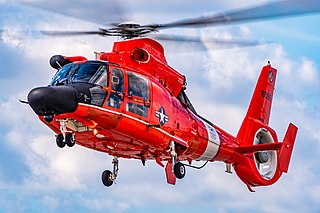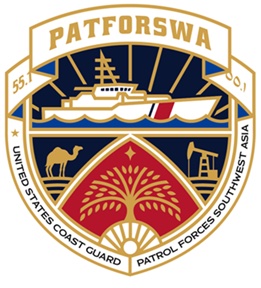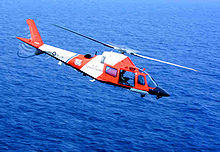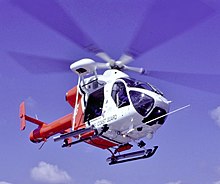
The United States Coast Guard (USCG) is the maritime security, search and rescue, and law enforcement service branch of the United States Armed Forces and one of the country's eight uniformed services. The service is a maritime, military, multi-mission service unique among the United States military branches for having a maritime law enforcement mission with jurisdiction in both domestic and international waters and a federal regulatory agency mission as part of its duties. It is the largest coast guard in the world, rivaling the capabilities and size of most navies.

The Eurocopter MH-65 Dolphin is a twin-engined helicopter operated by the United States Coast Guard (USCG) for medevac-capable search and rescue (SAR) and armed Airborne Use of Force missions. It is a variant of the French-built Eurocopter AS365 Dauphin.

The AgustaWestland AW109, originally the Agusta A109, is a lightweight, twin-engine, eight-seat multi-purpose helicopter designed and initially produced by the Italian rotorcraft manufacturer Agusta. It was the first all-Italian helicopter to be mass-produced. Its production has been continued by Agusta's successor companies, presently Leonardo S.p.A..

SLNS Vijayabahu (P627) is an Advanced Offshore Patrol Vessel of the Sri Lanka Navy. The ship is named after King Vijayabahu I, the warrior king of the medieval Sri Lanka who founded the Kingdom of Polonnaruwa.

United States Coast Guard Air Station Clearwater is the United States Coast Guard's largest air station. It is located at the St. Petersburg-Clearwater International Airport in Clearwater, Florida and is home to nearly 700 USCG aviation and support personnel. As of March 2021, there are ten MH-60T Jayhawk helicopters and four HC-130H Hercules aircraft assigned to CGAS Clearwater. Also on static display is USCG 1023, a restored Grumman HU-16 Albatross.

The Sikorsky MH-60T Jayhawk is a multi-mission, twin-engine, medium-range helicopter operated by the United States Coast Guard for search and rescue, law enforcement, military readiness and marine environmental protection missions. It was originally designated HH-60J before being upgraded and redesignated beginning in 2007.

USCGC Dallas (WHEC-716) was a United States Coast Guard high endurance cutter commissioned in 1967 at the Avondale Shipyard in New Orleans, Louisiana. She was the sixth ship or boat to bear the name of Alexander J. Dallas, the Secretary of the Treasury under President James Madison (1814–1816). She is one of twelve Hamilton-class cutters built for the Coast Guard.

A door gunner is a crewman tasked with firing and maintaining manually directed armament aboard a military helicopter. The actual role will vary depending on the task given on a particular mission. For certain aircraft a door gunner would use a fully automatic Gatling gun placement. On many larger aircraft such as military planes a turret is used along with heavy cannons.

Rescue swimmer is a designation given to rescue specialists, most commonly in the service of the military. Rescue swimmers usually are charged with the rescue, assessment, and rendering of medical aid to persons in distress in the sea, on the land, or in the air. This highly specialized position is extremely challenging.

Law Enforcement Detachments or LEDETs are specialized, deployable maritime law enforcement teams of the United States Coast Guard. First established in 1982, their primary mission is to deploy aboard U.S. and allied naval vessels to conduct and support maritime law enforcement, interdiction, or security operations. LEDETs are the operational elements of the Coast Guard’s two Tactical Law Enforcement Teams (TACLETs) which are part of the Coast Guard’s Deployable Specialized Forces (DSF). As of April 2010 there are seventeen LEDETs.
The United States Coast Guard is the coastal defense, search and rescue, and maritime law enforcement branch of the United States Armed Forces and is one of the country's eight uniformed services. It carries out three basic roles, which are further subdivided into eleven statutory missions. The three roles are:

USCGC Boutwell (WHEC-719) was a United States Coast Guard high endurance cutter based out of San Diego, California. Named for George S. Boutwell, United States Secretary of the Treasury under President Ulysses S. Grant. Boutwell engaged in many Coast Guard missions, including search and rescue, law enforcement, maritime security, and national defense.

USCGC Tampa (WMEC-902) is a United States Coast Guard medium endurance cutter. She was commissioned 16 March 1984. Her motto, "Thy way is the sea, thy path in the great waters", matches the inscription that is engraved on the memorial at Arlington National Cemetery for the 131 persons lost following the sinking of a previous cutter Tampa on September 18, 1918.

USCGC Valiant (WMEC-621) is a United States Coast Guard multi-mission medium endurance cutter in service since 1967. Valiant is home ported in Jacksonville, Florida and operates in the Atlantic Ocean, Caribbean Sea and Gulf of Mexico for the Commander, Coast Guard Atlantic Area. Missions include search and rescue, maritime law enforcement, marine environmental protection, and national defense operations.

The Special Missions Training Center (SMTC), also known as Joint Maritime Training Center (JMTC), is a joint United States Coast Guard, Navy, and Marine Corps training facility located on Camp Lejeune, North Carolina. SMTC's mission is to provide relevant and credible Maritime Security Training and Operational Testing and Evaluation in support of Department of Defense and Department of Homeland Security missions. SMTC comprises four main divisions: Weapons, Port Security, Engineering / Logistics, and Fast Boat.

The Deployable Specialized Forces (DSF) —formerly Deployable Operations Group— part of the United States Coast Guard that provide highly equipped, trained and organized deployable specialized forces, to the Coast Guard, United States Department of Homeland Security (DHS), United States Department of Defense (DoD) and inter-agency operational and tactical commanders. The command was formerly headquartered in Arlington, Virginia, it was established on 20 July 2007, and was commanded by a captain, the command was decommissioned by the Commandant of the Coast Guard, Admiral Robert Papp on 1 October 2013, although many of the units existed long before the 2007 commissioning. Upon decommissioning the command, the units previously assigned to the DOG were split between Coast Guard Pacific and Atlantic Area commands. The units were soon reorganized under Deployable specialized forces (DSF).

Patrol Forces Southwest Asia (PATFORSWA) is a United States Coast Guard command based in Manama, Bahrain. PATFORSWA was created in November 2002 as a contingency operation to support the U.S. Navy with patrol boats. The command's mission is to train, equip, deploy and support combat-ready Coast Guard forces conducting operations in support of Operation Iraqi Freedom (OIF), Operation Enduring Freedom (OEF) and Operation Inherent Resolve (OIR) in the Naval Forces Central Command's area of responsibility. It was commissioned as a permanent duty station in June 2004. In July 2003 PATFORSWA moved from its own compound to facilities at Naval Support Activity Bahrain.

USCGC Richard Dixon is the United States Coast Guard's thirteenth Sentinel-class cutter, commissioned in Tampa, Florida, on June 20, 2015. She arrived in her home port of San Juan, Puerto Rico on June 24, 2015.

USCGC Joseph Tezanos (WPC-1118) is the United States Coast Guard's 18th Sentinel-class cutter. She was commissioned on August 26, 2016. She was the sixth of the first cohort of six Fast Response Cutters home-ported in San Juan, Puerto Rico.

Donna L. Cottrell is a retired United States Coast Guard rear admiral who last served as the Coast Guard District 9 Commander. In this role, she served as the senior Commander for the Great Lakes and Saint Lawrence Seaway, an area that covers eight states. The Area of Operations for the command accumulates over 6,700 miles of shoreline and 1,500 miles of international shoreline with Canada. In addition, she previously oversaw the service level command, Helicopter Interdiction Tactical Squadron (HITRON) out of Jacksonville, FL.

























